Mastering the Art of Hatching Chicken Eggs
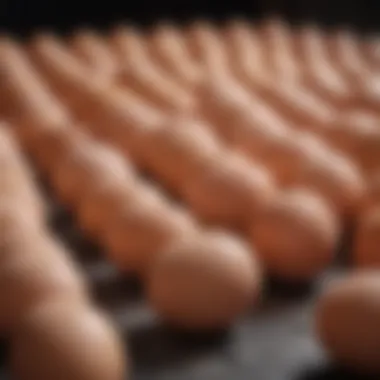
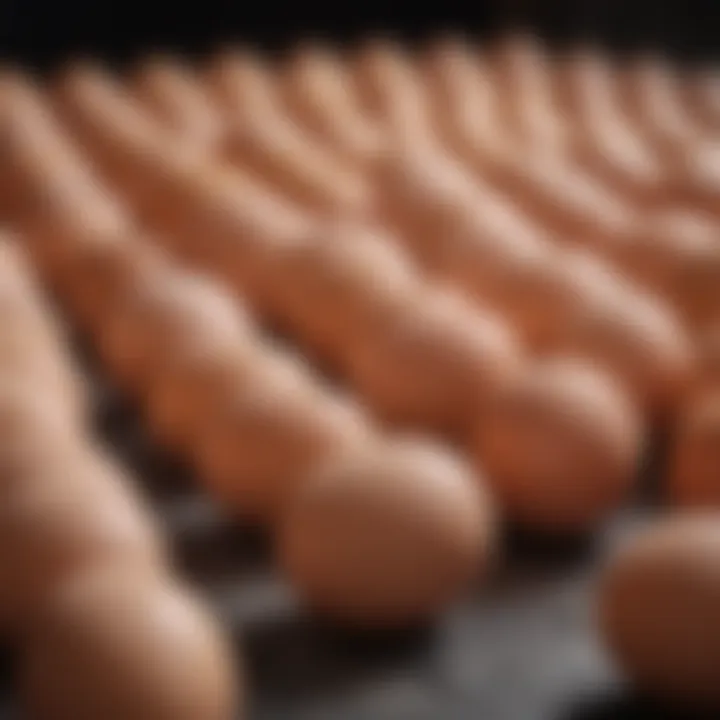
Intro
Hatching chicken eggs can seem like a bit of a puzzle, right? It's not just about tossing a few eggs in a box and waiting for the peeping to start. There’s a whole world of techniques and methods that can make or break the hatching process. Whether you're a seasoned farmer or just a backyard enthusiast aiming to raise a few clucking companions, understanding what this entails is key to a fruitful endeavor. This guide serves as your roadmap through the intriguing journey of bringing future layers and broilers into the world.
Overview of the Topic
Definition and Importance
At its core, hatching chicken eggs is the process of nurturing fertilized eggs until they hatch into chicks. The significance cannot be overstated, especially in agriculture. It’s not just about food production; it’s also about genetic improvements and raising healthy poultry. Proper hatching practices ensure that you maximize the potential of each egg, and in turn, contribute to sustainable farming practices.
Current Trends
In recent years, the trends in egg hatching have shifted. With more people taking a keen interest in self-sufficiency, urban or suburban farming, and organic practices, educational resources around hatching have flourished. Techniques such as dual-purpose breeds and backyard hatcheries are gaining traction, offering a pathway for greater independence in food production. To stay relevant, understanding these shifts is crucial.
Key Techniques and Practices
Step-by-Step Guide
- Selecting the Right Eggs: This first step is vital. Look for eggs that are clean, undamaged, and preferably from a reputable source.
- Preparing the Incubator: An incubator that mimics a hen’s warm body is essential. Set the temperature to around 99.5°F (37.5°C) and ensure good humidity levels, typically around 50-55% during incubation.
- Turning the Eggs: Eggs need to be turned regularly to prevent the embryo from sticking to the shell. A simple turn twice a day often suffices.
- Monitoring Conditions: Keep an eye on temperature and humidity. Too much fluctuation can decrease hatchability.
- Lockdown Phase: About three days before hatching, stop turning the eggs and increase humidity to around 65-70%.
- Hatching: Be patient. It may take a full 21 days for the chicks to emerge.
Tools and Equipment Needed
- Incubator: Look for one with reliable temperature and humidity control.
- Thermometers and Hygrometers: To accurately monitor the settings.
- Egg Turner: This makes it easier and helps ensure regular turning.
- Candling Light: A handy tool for checking the development of embryos mid-way through incubation.
Challenges and Solutions
Common Obstacles
Several issues can arise when hatching chicken eggs. Some of the more prevalent include:
- Temperature Fluctuations: This can result from faulty incubators.
- Low Humidity: Insufficient moisture can dry out eggs, affecting hatch rates.
- Weak Embryos: Genetic factors or poor egg handling can lead to problems.
Innovative Solutions
- Invest in a Quality Incubator: Going for a more precise model can save a lot of hassle.
- Use Digital Monitors: They offer real-time readings, ensuring everything stays within a safe range.
- Select Robust Breeds: Some breeds are better suited for novice hatchers, as they tend to have higher viability rates.
"Investing in knowledge is the best return on investment you can make when it comes to hatching chicken eggs."
Understanding these various aspects and preparing adequately can significantly enhance your hatching success rates. Stay tuned for further sections, which will dig deeper into the intricacies that come along with this age-old practice.
Prologue to Chicken Egg Hatching
Hatching chicken eggs is not just a simple task; it’s a complex journey that marries science with artistry. The significance of this topic cannot be overstated, especially for those deeply immersed in agriculture, whether they are seasoned farmers or passionate hobbyists. Proper hatching lays the groundwork for a healthy and productive flock, affecting both economic returns and the joy of nurturing life.
One key benefit of understanding the intricacies of egg hatching is the ability to optimize hatch rates. A farmer armed with knowledge about incubation conditions, egg handling, and the lifecycle of chickens can greatly improve the outcomes of their hatching endeavors. This isn’t merely about following a guideline; it’s about appreciating the delicate balance required at every stage, from the selection of fertile eggs to the delicate timing during the hatching process.
Factors such as temperature, humidity, and even the positioning of eggs during incubation play a crucial role. Moreover, being keenly aware of these considerations helps in troubleshooting common issues that may arise, such as low hatch rates or weak chicks. Understanding what goes into the lifecycle of chickens aids farmers in making informed decisions that lead to both the short-term goal of a successful hatch and the long-term sustainability of their operations.
Importance of Proper Hatching Techniques
When it comes to hatching techniques, precision is paramount. Using improper methods can lead to significant stress for the developing embryos or, worse, cause complete hatch failures. The importance of adhering to proper techniques cannot be understated. By paying close attention to details such as temperature variations and humidity levels, farmers can foster an environment conducive to embryonic development.
Additionally, regular turning of the eggs ensures that the embryos are developing evenly, preventing potential deformities. Take note that not all breeds of chickens require the same hatching techniques. For instance, some may have unique temperature preferences, while others thrive at different humidity levels. Therefore, customizing approaches based on breed characteristics is essential for achieving higher success rates.
"Successful hatching is the result of careful planning and attention to details that the untrained eye might overlook."
Understanding the Lifecycle of Chickens
To appreciate the hatching process, one must understand the lifecycle of chickens. Chickens have distinct stages of development, starting from the fertilized egg to the eventual emergence of a chick. Each of these phases brings its own set of requirements and challenges, making it critical for anyone involved in hatching to grasp these stages fully.
The lifecycle begins when sperm fertilizes the eggs within the hen. Following fertilization, avian embryos develop over a 21-day incubation period, during which the eggs need precise conditions to ensure successful growth. Knowing these stages allows for better management and intervention when necessary.
As the incubation period progresses, various physical changes occur within the egg, such as increased weight and internal movements, signaling that development is on track. Understanding these signs is invaluable, as it prepares farmers to make informed decisions regarding interventions, such as candling to check embryo viability. Recognizing these signs can truly make or break a hatching cycle, especially in fast-paced agricultural operations.
In summary, mastering the art of chicken egg hatching requires more than just following instructions. It demands an appreciation for the lifecycle of the species, the minutiae of incubation, and the practice of proper techniques that ensure successful outcomes. This holistic understanding offers farmers and enthusiasts the tools needed to navigate the delightful and complex world of avian reproduction.
Selecting Fertile Eggs
Selecting fertile eggs is a crucial step in the chicken hatching journey. Failing to choose the right eggs can lead to disappointing hatch rates and wasted resources. When embarking on this process, it’s imperative to understand that not all eggs are created equal. The selection process has a big impact on the success of your hatching endeavor.
Choosing fertile eggs can influence various aspects of development. For instance, fertilized eggs from healthy parents tend to yield stronger, more robust chicks. Additionally, the genetics of the breed you select can directly affect the characteristics of the hatchlings. For example, some breeds are known for their high egg production, while others might boast superior meat quality. It’s a fine line between understanding what you want and what particular breeds can deliver.
Recognizing Fertility Indicators
When hunting for fertile eggs, look for key indicators that signal their viability. A solid approach is to seek eggs with a uniform shape; misshapen or excessively large eggs may indicate underlying issues. The eggshell’s color can also offer hints; for instance, darker or richer colors often suggest healthy hens. Another tip is to check the eggs' weight; fertile eggs will generally feel heftier. Through experience, many poultry enthusiasts develop a knack for spotting these indicators.
"A good eye can save you a lot of heartache in the long run."
The freshness of the eggs cannot be overstated. Older eggs have a decreased chance of hatching due to declining viability. Conducting a float test can be beneficial; if an egg sinks, it's fresh; if it floats, it’s past its prime. This simple test can save untold frustration when it comes time to incubate.
Choosing the Right Breeds
The importance of breed selection can’t be overstated when it comes to hatching. Different breeds have varied hatchability rates, and some are more suited to specific environments than others. For example, heritage breeds, like the Plymouth Rock or Rhode Island Red, can be excellent choices for novice hatchers due to their robust nature.
However, if your goal is high egg production, you might want to look into breeds such as the Leghorn or the Australorp. These breeds typically offer more consistent outputs, which is crucial for farmers aiming for sustainability in production. It's key to remember that environmental factors also play a role; chickens raised in free-range circumstances might behave differently compared to those raised in typical barn settings.
Additionally, nurturing a diverse gene pool is vital. Genetic diversity can promote resilience, allowing the flock to better withstand environmental stresses and diseases. Selecting eggs from various breeds not only enhances your flock but can also create a more dynamic farm ecosystem.
Egg Storage and Preparation
Before embarking on the journey of hatching chicken eggs, it's crucial to understand that proper storage and preparation of the eggs can significantly influence the success of the hatching process. Failure to follow appropriate storage techniques can lead to poor hatch rates, significantly reducing the excitement of seeing those new chicks. Thus, paying close attention to these two facets is not only beneficial but vital for enthusiasts and farmers alike.
Optimal Storage Conditions
Storing eggs correctly is like setting the stage for a grand performance; everything needs to be just right for the show to go on. The fertility and viability of eggs depend largely on how they are stored prior to incubating. Here are some important points to consider for optimal storage:
- Temperature: Ideally, chicken eggs should be stored in a cool, stable environment between 45°F and 65°F (7°C to 18°C). Fluctuations in temperature can cause stress to the developing embryo, impacting its growth and hatchability.
- Humidity: Maintaining the right humidity level is key. A humidity level of 70% is optimal in storage conditions to prevent moisture loss. Using damp sponges or containers of water can help achieve this.
- Orientation: It's important to store eggs with the pointed end facing down. This positioning keeps the yolk centered, which is fundamental for developing chicks.
- Cleanliness: Only use clean eggs for storage. Dirty eggs can harbor pathogens that may affect the embryo’s health. Any eggs showing signs of dirt should be gently cleaned with a dry cloth.
These steps sound simple, but they form the bedrock of successful incubation. Proper storage not only preserves the eggs but also prepares them for the upcoming stages of hatching.
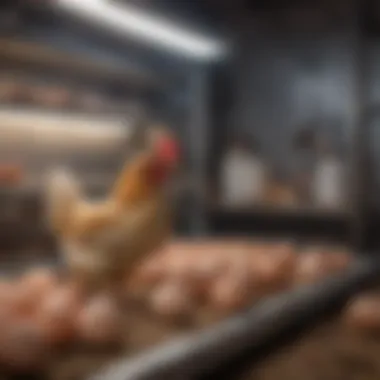
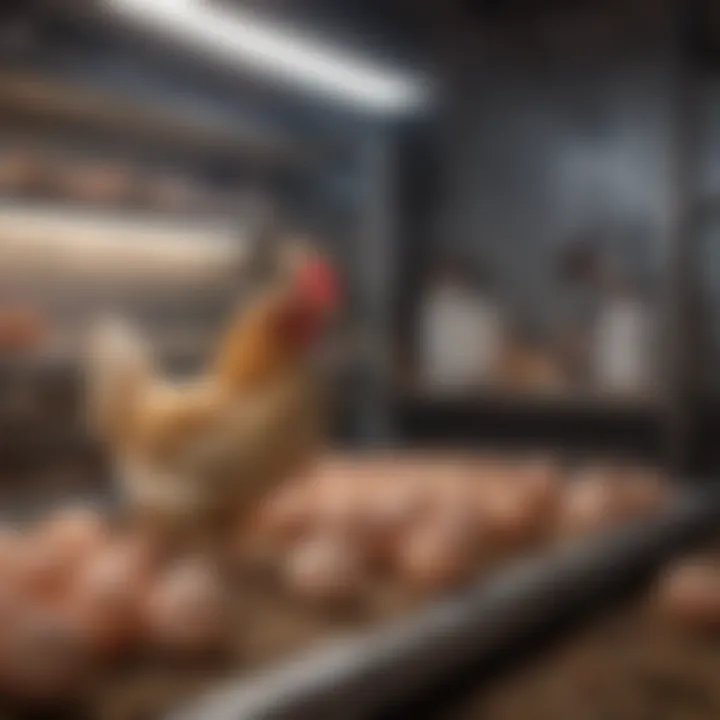
Pre-Hatching Preparation
Preparation for hatching goes beyond just choosing the right eggs; it encompasses a holistic approach to ensure everything is set up for a successful outcome. Here are some integral steps in pre-hatching preparation:
- Inspections: Before placing your eggs in the incubator, visually inspect each egg for cracks or imperfections. Discard any damaged eggs, as they have a much lower chance of hatching and can introduce contamination.
- Adjusting the Incubator: Make sure that your incubator is functioning correctly before the eggs arrive. Spend time calibrating the temperature and humidity settings. Give it a test run for a day or two to ensure everything is stable.
- Turn the Eggs: If you can, gently turn the eggs a couple of times before they go into the incubator. This mimmics natural conditions in a hen's nest and can aid in development.
- Timing: Mark your calendar! Know when to expect your chicks to hatch. This helps in planning for the necessary equipment and resources you’ll need post-hatching.
"Proper preparation today leads to successful hatching tomorrow."
Incorporating these steps ensures that you're not just setting the eggs in an incubator and hoping for the best. Instead, you're actively contributing to the nurturing environment needed for those little beings to thrive. With the right storage conditions and thoughtful pre-hatching preparation, you're well on your way to a successful hatching experience.
Understanding Incubation Basics
In the journey of hatching chicken eggs, understanding incubation basics forms the bedrock of success. It's not just about the act of placing eggs inside a box; it’s a meticulous process that balances science and art. Each egg becomes a vessel of potential, where warmth, humidity, and care merge to give life. For both seasoned farmers and newcomers, grasping these fundamentals can significantly elevate hatch rates and reduce setbacks.
When considering incubation, various elements come into play that directly affect the developmental stages of embryos within the eggs. The right incubator can be a game changer. It dictates the conditions under which the eggs will develop—much like a mother hen, ensuring her clutch is kept just right. Disregarding these principles could mean the difference between a bustling coop of chicks and a disappointing batch of duds.
Types of Incubators
There are primarily three types of incubators that chicken hatchers might encounter: forced-air, still-air, and cabinet incubators. Each type serves its purpose, and understanding their unique characteristics can lead to smarter choices in the hatching process.
- Forced-air incubators use fans to circulate air, keeping temperature and humidity levels consistent. This type is effective as it reduces hot or cold spots, promoting even development across all eggs.
- Still-air incubators, in contrast, rely on natural convection currents to maintain temperature. They're typically used for small, personal hatching projects. However, they may require more attention to ensure temperature levels stay stable, as there's less automated control.
- Cabinet incubators are robust and often used commercially. They can hold a larger quantity of eggs and come equipped with more sophisticated monitoring systems to assist farmers in maintaining optimal incubation conditions.
Selecting the right incubator hinges on several factors: the scale of hatching, budget, and the intended outcomes. For small scale hobbyists, a still-air incubator might suffice, while large-scale operations may benefit from the advanced features of a cabinet incubator.
Setting Up the Incubator Environment
Getting the incubator ready often feels like preparing a nursery. The setting must be conducive not only to the eggs but also to the farmer’s peace of mind. Key considerations include temperature, humidity, and ventilation, all of which need careful calibration.
- Temperature is paramount; most chicken eggs require a steady 99.5°F (roughly 37.5°C). Having a reliable thermometer—preferably a digital one—ensures that temperature fluctuations can be managed in real-time.
- Humidity levels also need careful monitoring. Ideally, humidity should hover around 50-55% for most of the incubation period, spiking to 65-70% in the final three days before hatching. Adding water trays or sponges can assist in maintaining that moisture, but too much could drown the developing chicks.
- Ventilation plays a quieter yet crucial role. Fresh air must circulate, which provides necessary oxygen for the embryos and removes excess carbon dioxide. Implementing proper airflow systems or simply ensuring that the incubator’s vents aren’t blocked can make a world of difference.
Facilitating a conducive environment doesn’t just help with hatching; it cultivates a responsive atmosphere for future endeavors in poultry farming. A well-prepped incubator reflects diligence and commitment, two traits that breed success in any agricultural venture.
"The care you put into hatching eggs today shapes the potential of your flock tomorrow."
Temperature and Humidity Control
Temperature and humidity control during the hatching process is like the delicate art of balancing a well-tuned instrument. If either gets out of whack, the consequences can be grim—poor hatch rates or unhealthy chicks are just the tip of the iceberg. In the realm of poultry farming, understanding how to maintain these two critical factors can mean the difference between a successful hatch and a complete flop.
Proper temperature management ensures that the embryos inside the eggs develop at the right pace. Too hot, and you risk overheating the eggs; too cold, and growth stalls. When we think about humidity, things can get just as tricky. The right moisture levels prevent the eggs from drying out, which is essential for the chick's development. Without sufficient humidity, the membranes can shrink, making it nearly impossible for the chick to break free during hatching.
In this section, we’ll dive deeper into specific temperature ranges you should aim for, as well as how to keep an eye on humidity levels for optimal results.
Optimal Temperature Ranges
When it comes to hatching chicken eggs, the ideal temperature is generally around 99.5°F (37.5°C). This temperature point is a sweet spot—a comfy zone for the embryos that helps them grow properly.
Here are some important considerations:
- Consistency is Key: Fluctuating temperatures can confuse the developing chick. It's essential to maintain a consistent environment.
- Incubator Calibration: Ensure your incubator is accurately calibrated. Misreadings can lead to disaster.
- Use a Thermometer: A good thermometer can be your best friend. Don’t rely solely on the incubator’s default readings.
- Check the Accessibility: Sometimes, temperatures can differ within different parts of the incubator, so keep an eye on all angles.
Monitoring Humidity Levels
Humidity plays a pivotal role in chick development. Too little humidity may lead to shriveled chicks while too much can create a breeding ground for mold and other issues. The ideal relative humidity level during incubation is typically set between 40% and 50%. As the hatch day approaches, this should be raised to 65% to 70% to facilitate the hatching process.
Here’s how to effectively monitor humidity:
- Hydrometers: Investing in a reliable hygrometer can provide real-time readings of humidity levels in your incubator.
- Water Sources: Ensure you have enough water in the incubator. Adding water trays or sponges can help boost humidity levels, especially as the hatching phase nears.
- Open the Door Sparingly: Every time you open the incubator, you let humidity escape. Minimize door openings to maintain a stable environment.
"Temperature and humidity control are not just mere numbers; they represent the life and death of the fragile beings waiting to hatch."
By adhering to these guidelines, you'll be setting the stage for a safe and welcoming environment for the chicks to thrive. Managing temperature and humidity correctly lets you cradle the eggs in the perfect conditions they need, paving the way for successful hatches.
Turning and Positioning Eggs
Turning and positioning eggs throughout the incubation process is fundamental for ensuring successful hatching. Eggs are living entities during this delicate period, and each factor plays a pivotal role in their development. From providing the right orientation to facilitating their movement within the shell, these practices directly influence embryo health and viability.
Importance of Regular Turning
Turning eggs frequently is a practice that should not be underestimated. Regular turning promotes proper blood circulation within the developing embryos and helps maintain the correct temperature distribution. This action prevents the embryo from sticking to the shell membranes, which can lead to deformities during hatching.
Typically, eggs should be turned at least three to five times a day. If the eggs are left stationary, the developing embryo may adhere to the shell, which can cause significant complications during the final stages of hatching.
Besides physical health benefits, regular turning also helps to establish a pattern of environment changes for the embryos. They become accustomed to consistent warmth and movement rather than abruptly facing a new position or temperature shift. This can be particularly important right before they hatch when they begin to move and adjust in preparation for the external world.
"Turning eggs is like giving them a supportive nudge in the right direction, fostering a healthy environment for life to flourish."
Positioning Techniques for Optimal Development
The way eggs are positioned inside an incubator is equally crucial. The ideal orientation is often pointy end down, which helps facilitate the hatch process. This positioning allows the air cell, located at the larger end of the egg, to form properly and ensures that the developing chick can breathe as it begins its external pip.
Here are some positioning techniques to keep in mind:
- Use an Egg Turner: This device can automate the turning process, reducing the manual labor and ensuring consistency.
- Set Eggs in a Crowded Space: When eggs are packed too tightly, it's difficult for air to circulate. This can lead to uneven heating. Make sure each egg has enough room to allow for air flow and turning.
- Monitor Orientation: Always double-check the egg's position when placing them in the incubator. Having them consistently oriented will help maximize hatch rate potential.
- Avoid Frequent Handling: While it's important to turn them regularly, avoid holding the eggs too long. The warmth from your hand can create temperature fluctuations that disrupt development.
By carefully considering both the turning and positioning of eggs, you can set the stage for a successful hatching experience, paving the way for healthy chicks to emerge.
Monitoring Progress and Development
Monitoring the stages of chick development is vital in ensuring a successful hatching process. By keeping a close eye on progress, breeders can mitigate potential challenges and enhance the likelihood of good hatch rates. Knowledge of chick development stages equips farmers with the ability to identify when intervention is necessary. During the incubation period, various factors must be considered, such as temperature fluctuations, humidity levels, and the overall condition of the eggs. Each of these elements plays a significant role in the overall health and viability of the embryos.
Incorporating methods like candling allows breeders to assess the condition of the eggs, ensuring that optimal conditions are maintained throughout the incubation. Moreover, recognizing subtle signs of distress or abnormal development can enable swift action, preventing catastrophic failures in the hatch.
"Proper monitoring throughout the hatching process is the cornerstone of successful chick breeding."
Candling Techniques for Progress Checks
Candling is a simple yet effective method for checking the development of embryos within eggs. This technique involves holding a light source against the egg to reveal its contents. Farmers can assess the progression of the embryo by observing various stages of development. With candling, it's important to do it at key intervals of the incubation period.
- Days 5-7: At this stage, you should notice the formation of blood vessels, which appear as intricate networks within the egg.
- Days 10-14: Expect to see the embryo��’s outline quite clearly. If the egg appears dark with no visible veins, this might indicate a non-viable egg.
- Days 18-21: By now, the embryo takes up most of the egg’s space. Checking for movement or shadowing can confirm that the chick is developing normally.


Remember to handle the eggs gently to avoid disrupting the embryos inside. Each time you candle, be sure to mark your observations in a notebook to track progress.
Identifying Potential Issues
Despite careful preparations, issues may arise during the hatching process. Recognizing these problems early can make a world of difference. Some common signs to look out for include:
- Developmental Delays: If candling reveals embryos that are significantly behind schedule, it could indicate poor conditions or genetic factors.
- Fluid Accumulation: Accumulated fluid inside the egg may suggest humidity problems, which can lead to abnormalities.
- Unusual Smells: A bad odor can be a warning sign of decay, indicating that the egg is no longer viable.
Correcting these issues often involves fine-tuning the incubation environment, ensuring that the temperature and humidity settings align with best practices. Documentation of issues faced during previous hatching attempts can also be useful in recognizing patterns and avoiding repeating mistakes.
Developing a keen eye for these signs allows chicken breeders to take corrective action proactively, ultimately leading to improved hatch rates and healthier chicks. Monitoring progress isn’t just a precaution; it’s a part of the commitment to responsible poultry farming.
Egg Hatching Process
The egg hatching process is a crucial stage in avian reproduction, determining the success of bringing new life into the world. At this point, the conditions established through previous preparations come to a head, with all the intricate details affecting the eventual outcome. Proper management during this phase can mean the difference between a successful hatch and the disappointment of unhatched eggs.
Understanding Internal and External Pip
To break it down, the internal pip occurs when the chick starts to penetrate the inner membrane of the egg and breaks through to the air cell. You can think of it like a baby first taking its breath—after days in a quiet shell, it finally gets to experience the outside world. This moment is vital because it allows the chick to absorb the remaining yolk. The external pip follows later when the chick cracks through the harder eggshell. This second phase signifies it’s almost ready to make its grand entrance.
Monitoring these pivotal moments is essential. Both pips inform the caretaker about the chick's progress. Even the seasoned hatchers may need to approach this with care; if conditions like temperature and humidity seem off, these pips could delay or even hinder the hatching process. Keep a watchful eye; here, every hour can count!
Timing of Hatching Events
When it comes to the timing of hatching events, it's a bit like waiting for a pot to boil. One moment, it feels stagnant, and then, suddenly, you're in the thick of it as those chicks begin their emergence—a flurry of activity! The average incubation period for chicken eggs is around twenty-one days. However, it’s not quite as straightforward as one might think.
Eggs may hatch anywhere from a few hours to over a day apart. Factors affecting this timing include genetics, egg size, and environmental conditions. It’s beneficial to track these events, as a mismatch in timing can lead to complications.
- Pre-Hatch Signs: Be aware of sounds, vibrations, and increased activity just before they rise from their dormancy.
- Document the Process: Keeping a log of when each egg reaches the respective stages provides insight into future hatching cycles.
- Embrace the Variation: Understand that while it’s crucial to stick to general timelines, some may hatch sooner or later than others.
"A well-timed hatch can bring joy and surprises. But relying on universal timings alone may send you down the wrong hatchway."
The thrill in this process is not just about watching little chicks come to life; it's the careful orchestration of nature and nurture, making for an exciting yet delicate journey toward new beginnings. By fully grasping these phases, you can pave the path to a successful hatch, setting the stage for healthy chicks and a thriving agricultural venture.
Post-Hatching Care
After a long wait, the moment of hatching has arrived, and tiny chicks begin to break free from their shells. However, the work doesn’t end here; in fact, it’s just the beginning. Post-hatching care is a critical phase that contributes to the well-being of the newly hatched chicks and sets the stage for their future development. It involves understanding their immediate needs and providing the right environment for optimal growth.
Providing Immediate Support
As soon as chicks emerge from their eggs, they require some immediate support to get off on the right foot. First steps involve ensuring they are dry and warm. Immediately after hatching, chicks are wet and vulnerable. A brooder, which is essentially a warm and safe area, should be set up in advance to welcome them. This can be a simple box with a heat source, keeping the temperature around 95°F for the first week and gradually decreasing as they grow.
Here are essential aspects to consider for immediate support:
- Temperature Control: Monitor the heat in the brooder closely. If chicks crowd together, they may be too cold. Conversely, if they are spread out, it might be too hot.
- Ventilation: Good airflow is important. Stale air can lead to health problems, so ensure that there are vents or small openings to promote fresh air circulation.
- Water and Food Access: Right after hatching, they might not have immediate interest in food, but providing clean water must be a priority. Consider utilizing shallow containers to prevent drowning, and introduce chick starter feed within the first few hours.
"A clean, safe start is the best gift you can give your chicks. The right conditions set the path for healthy growth and productivity."
Incorporating Nutritional Needs
To support the rapid growth of chicks, proper nutrition must be introduced very soon. Post-hatching nutrition heavily influences their overall health, strength, and resilience.
At this stage, incorporating a high-quality chick starter is vital. This feed is formulated to meet their specific growth requirements. Here are some key nutritional elements to focus on:
- High Protein Content: Look for feeds containing about 20-24% protein, essential for muscle and feather development.
- Essential Vitamins and Minerals: Providing a balanced diet with necessary vitamins, particularly A, D, and E, will help foster a strong immune system.
- Hydration: Clean water is crucial. Hydration should always be available as chicks can easily overlook their thirst when just hatching.
Remember, it’s not all about immediate needs—consistent access to proper nutrition and a supportive environment fosters longevity and productivity in your flock. Managing these early post-hatching factors will help elevate the possibilities for future success in your chicken rearing endeavors.
Common Challenges in Hatching
Hatching chicken eggs can be as rewarding as it can be challenging. While the ultimate goal is to see your baby chicks breaking through their shells, various hurdles may present themselves during the process. Understanding these common challenges is crucial for any farmer or enthusiast looking to improve their hatch rates and overall poultry health.
Skillful management of these issues can lead to a higher success rate, which is deeply beneficial considering the time and resources invested in raising chickens. Recognizing that hatching is not merely a straightforward task but a multifaceted journey helps in setting realistic expectations.
Addressing Low Hatch Rates
Low hatch rates might feel like a punch in the gut. When you put in the effort to select the best eggs, set up your incubator meticulously, and maintain the right temperature and humidity levels, it's disheartening to see fewer chicks than expected. There are myriad reasons why hatch rates can drop.
- Egg Quality: Cracks, age of eggs, or improper storage before incubation can severely impact viability.
- Incubator Conditions: Even minor fluctuations in temperature or humidity can result in poor outcomes. It's imperative to closely monitor these conditions often.
- Turning Issues: Not turning the eggs regularly can disrupt embryo development, leading to non-hatchable eggs. A regular schedule must be adhered to.
To address low hatch rates:
- Regularly inspect your incubator for consistency in conditions.
- Be vigilant about egg selection and handling.
- Consider investing in an auto-turning incubator if manual turning is proving difficult.
Dealing with Egg Culling
Egg culling can be a tough call to make, but sometimes it's necessary for the overall health of your flock. Culling refers to the removal of eggs that are unlikely to hatch, which could be due to various factors such as cracks or abnormalities.
It's crucial to be selective during this process:
- Cracked Eggs: These pose a risk of contamination and should be set aside immediately.
- Undeveloped Eggs: Candling allows you to identify which eggs are not developing as expected.
Some guidelines to consider during egg culling include:
- Assess eggs at multiple stages of incubation to monitor progress.
- Keep a record of reasons for culling to inform future hatching practices.
Dealing with these aspects thoughtfully not only optimizes your hatch rates but also fosters a healthier flock in the long run. Recognizing when to let go can create room for stronger, healthier birds.
Factors Influencing Hatchability
Hatchability, the term that defines the success rate of egg hatching, can really make or break your poultry farming experience. Understanding what influences this critical aspect not only empowers farmers but also enriches enthusiasts looking to broaden their avian skills. Several elements come into play here, and a little insight into them can turn the tide in your favor, leading to healthier chicks and prosperity in your poultry endeavors.
Impact of Genetics on Hatchability
Genetics isn’t just a fancy term thrown around in agricultural discussions; it is a pivotal factor that contributes to successful hatching rates. Certain breeds of chickens exhibit characteristics that not only make them adept at laying eggs but also impact the eggs' hatchability. For example, heritage breeds like Rhode Island Reds tend to have better hatch rates compared to hybrids. This difference arises from the underlying genetic make-up that governs various traits, including fertility and vitality.
- Healthier breeds: Chickens that are bred for hardiness often pass on favorable genetic traits to their offspring, enhancing their overall resilience and survival rates post-hatch.
- Genetic diversity: Maintaining a diverse gene pool can also benefit hatch rates. Inbreeding can lead to diminished vigor in chicks, making them more susceptible to health issues.
It's essential, then, to consider not just the immediate parent-stock but also the broader genetic lineage. Engaging in good breeding practices can significantly enhance your hatchability rates.
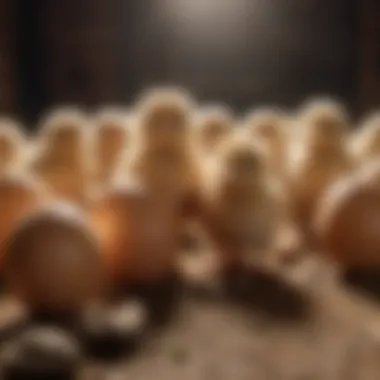
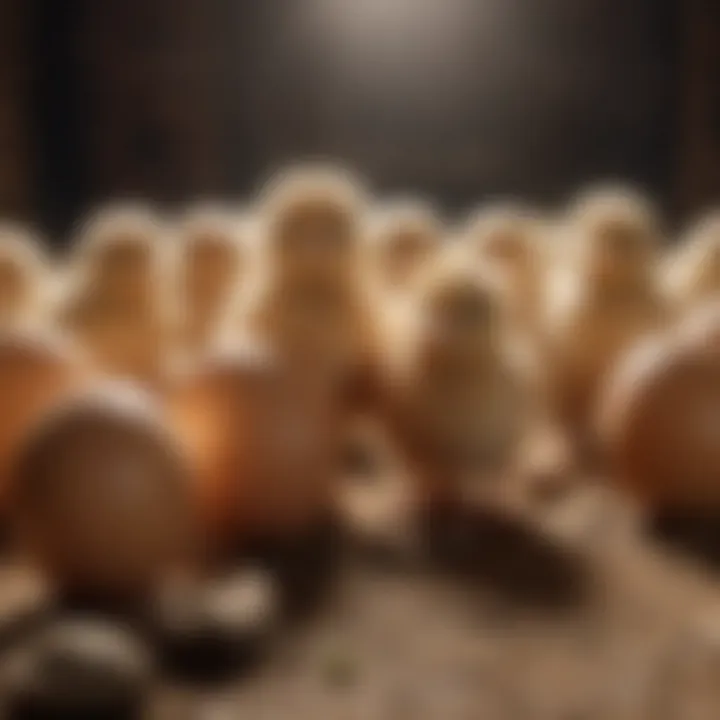
Environmental Effects on Development
The environment in which eggs are incubated plays a massive role in determining their development. A perfectly controlled incubator, complete with the right temperature, humidity, and ventilation, is crucial. Here are key environmental factors to watch out for:
- Temperature control: The eggs require a specific range of temperature, typically around 99 to 102 degrees Fahrenheit. Any fluctuations can halt development or, worse, kill the embryo inside.
- Humidity levels: Proper humidity is vital to ensure the chicks can pip successfully. Too much or too little moisture can hinder their efforts to break free from their shells.
- Ventilation: Fresh air is also a necessity, as developing embryos require oxygen while eliminating carbon dioxide, which accumulates over time.
Additionally, factors like drafts from nearby windows or heat sources can create a challenging environment for egg hatching. Creating a stable, predictable environment allows the embryos to thrive, ultimately promoting better hatchability.
"Controlling the environment is half the battle when it comes to hatching. If the conditions aren't right, even the best eggs can fall flat."
Keeping these factors in mind can help in nurturing a conducive atmosphere for successful hatching. By understanding the interplay between genetics and environmental conditions, anyone serious about chicken farming can capitalize on hatch rates, increasing the likelihood of success while doing what they enjoy most.
Technological Advances in Hatching
In the realm of poultry farming, technological advances in hatching perhaps serve as the new frontier. The evolution of hatching methods has transformed how farmers approach the egg incubation process, ensuring higher success rates and better chick quality. Modern tools and gadgets have emerged, proving to be quite useful in optimizing the hatching environment. This section will highlight key aspects of this topic, offering insights into the distinctions between traditional and modern methods, alongside the benefits that innovation brings to the table.
Mechanical Incubators vs. Natural Hatching
When weighing the effectiveness of mechanical incubators against natural hatching methods, a few considerations arise. Mechanical incubators, which can maintain precise temperature and humidity levels, offer a controlled environment. This is particularly beneficial in regions where Mother Nature might not cooperate.
- Precision: Mechanical incubators can be programmed to replicate the ideal conditions for hatching, ensuring that temperature and humidity are consistent throughout the incubation period.
- Scalability: Farmers who aim to scale their operations will find it easier to manage multiple trays of eggs simultaneously with an incubator. This efficiency can elevate production levels significantly.
Natural hatching, on the other hand, relies on the hen's instinct, where she cares for her clutch. Though this method has its charm, it can be unpredictable. Factors such as the hen's experience and environmental conditions come into play. It's worth noting:
- Broodiness: Not all hens will brood, and those that do have varying levels of attentiveness and experience.
- Space Limitation: A hen can only tend to a small number of eggs, limiting production unless multiple hens are involved.
Compatibility of both methods can be seen. Many farmers opt for a hybrid approach, starting with a mechanical incubator then placing the chicks under a hen once they have hatched. This method combines the benefits of technology with the natural nurturing abilities of a hen, potentially resulting in healthier chicks.
Innovations in Monitoring Technology
As we march further into the 21st century, innovations in monitoring technology for hatching are becoming indispensable. Improvements in data collection and analysis allow farmers to fine-tune their hatching processes continuously.
- Smart Incubators: These devices often come with Wi-Fi connectivity, letting users monitor and adjust conditions remotely via smartphones. Techniques like these help farmers stay ahead of potential issues.
- Data Analytics: With real-time data on temperature, humidity levels, and even egg development stages, farmers can make informed decisions. For instance, if the humidity drops below optimal levels, farmers can react quickly rather than waiting for visual cues or candling results.
- Automated Alerts: Alerts can be configured to notify farmers of any fluctuations from the desired conditions, reducing the room for human error significantly.
"In this age of technology, why leave your hatchery to chance? Embrace tools that keep you in the know without a hitch."
By incorporating these advanced monitoring tools into their workflows, poultry farmers can optimize hatching success rates and create a more sustainable farming method, poised for growth in the face of impending challenges in agriculture.
Sustainability in Chicken Farming
Sustainability in chicken farming has become a hot-button issue among farmers, consumers, and environmental advocates alike. As our world becomes more aware of the ecological ramifications of agriculture, the question of how to farm chickens ethically and responsibly takes center stage. Going green isn’t just a trend; it’s an essential shift towards ensuring that our farming practices are in harmony with the environment. This section dives into the vital aspects of sustainable chicken farming, weighing the benefits and considerations that farmers and enthusiasts must navigate.
Ethical Considerations in Hatching Practices
In the context of sustainability, ethical considerations in hatching practices play a pivotal role. Farmers need to recognize that each step, from selecting fertile eggs to directly managing the hatching environment, carries an ethical weight. The well-being of chicks, humane treatment of laying hens, and avoiding any hatchery practices that contribute to suffering are paramount.
For instance, when choosing breeding stock, it’s crucial to select breeds that are not only productive but also have good welfare profiles. Conscientious breeding can avoid many of the health problems seen in commercial poultry. Furthermore, employing practices such as ovarian health monitoring ensures that both the eggs and the hens are treated with care. Making ethical decisions in hatching can resonate through the entire supply chain, reflecting positively on the farm's reputation and customer loyalty.
Reducing Environmental Impact
Reducing environmental impact should be central to any chicken farming operation aiming for sustainability. Here are a few strategies that can be adopted:
- Efficient Resource Use: Utilizing renewable resources like solar energy can effectively lower the carbon footprint of operations.
- Waste Management: Composting chicken waste provides excellent fertilizer for crops while minimizing landfill contributions. It's a win-win, turning waste into a resource.
- Water Conservation: Establishing rainwater harvesting systems aids in managing water use responsibly.
- Diversified Farming Practices: Integrating chickens into mixed-use farming not only increases biodiversity but also promotes healthier ecosystems. This method decreases reliance on processed feeds and chemical inputs, leading to lower environmental strain.
It's crucial to think about long-term sustainability, not just immediate gains. Farmers who prioritize the environment tend to foster a more resilient operation.
"The future of farming is not just about producing more but doing so while giving back to the earth."
By embedding sustainable practices into chicken farming, practitioners contribute to a healthier ecosystem while potentially enhancing their bottom line. Understanding the balance between production and ethical responsibility leads to better practices that ensure viable farming for generations to come.
Future Trends in Poultry Hatching
The landscape of poultry hatching is evolving rapidly, driven by advancements in technology and an increasing focus on sustainability. The future trends in this field not only enhance efficiency but also aim for better animal welfare and environmental responsibilities. As farmers and enthusiasts delve into hatching techniques, understanding these trends becomes pivotal for optimizing practices and improving outcomes.
Predicted Developments in Breeding Techniques
The next few years are likely to see significant innovations in breeding techniques. It's not just a matter of choosing the right hen and rooster; the insights from poultry genetics will play an increasingly important role.
- Selective Breeding: Farmers will increasingly rely on genomic data to select birds that exhibit desirable traits such as higher hatchability and disease resistance. This method is on the rise because it allows for better predictability of offspring performance.
- Crossbreeding Innovations: New approaches will emerge, focusing on creating hybrids that thrive in diverse conditions. These birds may offer a range of benefits, from faster growth rates to improved egg production.
- Utilization of Data Analytics: Collecting data on breeding, health, and environmental influences will enable personalized strategies for ongoing improvement and performance.
Better breeding, alongside precise data collection, could radically change flock productivity and longevity.
The Role of Biotechnology
Biotechnology is set to revolutionize poultry hatching in ways that were once unimaginable. From gene editing to advanced disease management, the integration of biotech holds a treasure trove of possibilities.
- Gene Editing: Techniques like CRISPR could allow for the alteration of genetic traits that contribute to disease resistance or climate adaptation. This creates birds better equipped to handle challenges posed by changing environments.
- Vaccine Development: With biotechnology, vaccines can be created more quickly and tailored to specific outbreaks, ensuring flocks remain healthy and productive.
- Nutritional Enhancements: Biotech may enable the development of feed that enhances the nutritional value of eggs or improves growth rates without harmful additives, fostering a more sustainable agricultural practice.
Despite some ethical concerns surrounding biotechnology, its potential benefits cannot be ignored. As this field advances, it will likely usher in new best practices that align with modern agricultural demands while addressing both productivity and animal welfare issues.
Important Insight: The continuous integration of biotechnology and innovations will ensure poultry farming remains at the forefront of efficient, ethical food production.
End
The conclusion serves as a crucial wrap-up to this article, summing up the important lessons learned throughout the extensive discussion on hatching chicken eggs. It’s not just a chance to put a bow on what’s been covered; it’s a reminder of why understanding these processes matters profoundly for anyone involved in poultry farming.
Taking the time to master key knowledge areas—from selecting fertile eggs to utilizing the right incubatory conditions—enhances your success rates significantly. Each step in the hatching process is interconnected; neglecting one can throw a wrench in the works. Therefore, grasping the importance of proper practices cannot be overstated. The laid-out insights provide a solid foundation upon which effective and sustainable farming can be built.
"Knowledge is the key to success in hatchery management—every detail counts."
Understanding the lifecycle of chickens, controlling environmental factors, and maintaining egg quality are all threads that weave into the larger tapestry of poultry husbandry. Embracing these insights not only boosts hatchability rates but also fosters an ethical approach to chicken farming, which is increasingly relevant in today's world.
Recap of Key Insights
To distill the knowledge imparted in this guide:
- Selecting Fertile Eggs: Always prioritize eggs that show signs of fertility.
- Incubation Setup: Properly configure your incubator concerning temperature and humidity adjustments to mimic natural conditions optimally.
- Turning the Eggs: Rotate eggs to ensure even development; it's not as simple as setting and forgetting.
- Monitoring Development: Utilize candling techniques to ensure that all is progressing well inside the eggs.
- Post-Hatching Care: Immediate support is crucial for the health and growth of newly hatched chicks.
These elements ensure a more effective hatching process, leading to healthier chicks and a more fruitful farming operation.
Encouragement for Continued Learning
Just as the egg requires careful nurturing to hatch, so too does knowledge require fostering. The poultry industry is always evolving, and staying up-to-date with the latest trends and research is vital.
Consider engaging with communities that focus on chicken farming, whether through platforms like Reddit or Facebook. Real-world experience shared by fellow enthusiasts can often shed light on practical aspects that theoretical knowledge may overlook. Furthermore, exploring reputable sources such as en.wikipedia.org or britannica.com can enhance your comprehension of evolving techniques in breeding.
In addition, participating in workshops or courses can refine your skills and expand your network. Knowledge isn't static—it's a living, breathing part of sustainable farming practices that grows as we immerse ourselves further in the subject. The more you learn, the better equipped you'll be to tackle challenges and seize opportunities in poultry farming.



